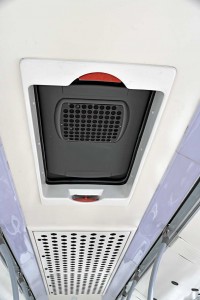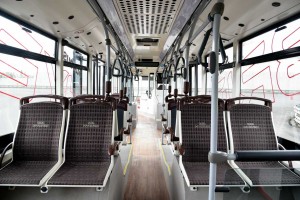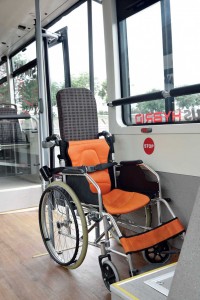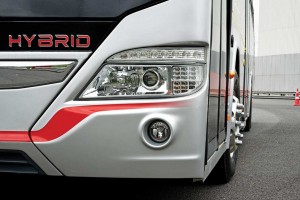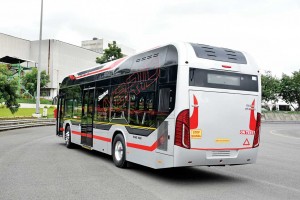Tata Starbus Hybrid is set to hit the roads of Bandra-Kurla Complex. It is a bus to watch out for.
Story by: Bhushan Mhapralkar
Photos by: Mahesh Reddy
Turn the key and watch the needles dance inside their dials before settling down to indicate that the bus is ready to move. Pressing the accelerator pedal does not lead to the desired result. It takes a moment to understand that it won’t; not until the air brake pressure has built up. This is indicated by the two lower dials on the Prima inspired instrument cluster. Once they have reached the prescribed level, the bus begins to move in near silence. This is unlike any other bus experienced until now. The three square buttons to the right – marked D, N and R, make up the gear shifter. There’s no clutch. On either side of the instrument cluster are a bank of switches, crucial to the smooth functioning of the bus. The driver console is attached to the steering column. The two are a single unit, and every time the steering is adjusted for reach the console also moves with it. A little ahead, the windscreen rises above like a giant surface. It helps with an uninterrupted view ahead. The Intelligent Transport System (ITS) module is to the immediate left of the driver console.
Loco on the road
The 12 m long Tata Starbus Hybrid picks up speed like a locomotive, devoid of any noise except for that distant whine of the motors. Expected to hit the roads of Bandra-Kurla Complex, Mumbai, by the end of this year or early next year, the bus draws images of Europe and its modern public transport medias. Contributing to this are the high standards of fit and finish and a modern build. This one feels like it has come straight out of Europe. Not surprising as 10 Tata Starbus Hybrid city buses are running on the roads of Madrid, Spain, since 2012 according to Dr. A K Jindal, Head of Engineering Research Centre (ERC) for Commercial Vehicles, Tata Motors. Till date they have accumulated more than 1.4 million kms cumulatively he adds. The chassis for the Madrid buses was built in India, including the design and integration. The body was built at Spain by Hispano. Mentions Dr. Jindal that they are bringing everything that is found on the Madrid bus to India in the form of this bus.
The ‘true’ low floor of this bus is spick and span. Its texture is wooden, and adds to the premium city bus image. No ordinary bus this is. The Madrid tender was won in competition with bus manufacturers from the world over, states Dr. Jindal. He adds, “All the design concepts, the driver console, and the driveline are proven.” In India, the bus has been built by ACGL, Goa. The know-how has been provided by Tata Motors. Featuring imported content from well known suppliers the Starbus Hybrid that is plying at Madrid, and will ply in Mumbai, has been designed, developed and integrated in India. Its software too has been developed in India. Explains Dr. Jindal, “We began working on a hybrid in 2007. We kept a slow pace as we did not see much traction. Also, the cost of equipment was high. We participated in the FIA motor show in 2009 with a diesel electric prototype. Discussions at Hispano about up-scaling the operations led to this participation. The Spanish Government was looking at procuring CNG hybrid buses. We responded by integrating a CNG engine.” In 2011, a CNG hybrid bus was displayed at Busworld Kortrijk, Belgium.
Speeds in the region of 60 kmph are attained in near silence. The 5-litre diesel (Euro 4 compliant) engine made by Tata Motors at its plant in Pune (located transversely at the rear and behind a partition that effectively seals the engine bay from the passenger compartment) powers a generator. The generator charges the Lithium-ion battery pack. The battery pack powers the two DC motors of 120kW each. Through a summation gearbox, the motors provide a turning force to the live (ZF) portal rear axle with an offset drive head. A series hybrid this bus is. The engine fires up only to generate electricity, and when the charge falls to a certain level. It plays no role in turning the rear axle. On the road, the rising speedo needle is the only indication of speed. The other is the blurring scenery around. The steering is offering a sincere feedback of what is passing under the front wheels.
A premium offering
Before making it to Madrid in 2012, the Starbus Hybrid sailed past rigid tests in freezing Nordic conditions, and in the high temperature areas of Malaga. Its success encouraged Tata Motors to start discussions with BMTC and DHI in India. Displayed at Auto Expo 2016, the bus attracted a crowd with its looks and build. If the stickering added to what could be termed as an attractive and thoroughly modern design, the icing on the cake was the ‘true’ low floor interior with high standards of fit and finish, and the requisite bells and whistles. Hidden behind the modern appearance of the Starbus Hybrid is hours of painstaking work. The highly charged team at Tata Motors developed a parallel hybrid bus alongside this series hybrid bus on an existing low entry (RELE) rear engine platform. Four CNG parallel hybrid concept buses were deployed at the (Delhi) Common Wealth Games in 2010 to highlight the technical capability of the Indian suppliers. It was later tried out by BEST and one other bus transport organisation. The 18 to 30 per cent improvement in fuel efficiency, subject to duty cycle, was highly appreciated. Merge government subsidy did not help much. FAME did not exist then. It changed the scenario upon its arrival but the allocation is seeming to fall short. Tata Motors was directed to MMRDA with a reason that they have funds and could invest in such buses. The Starbus Hybrid is claimed to cost a competitive Rs.2 crore.
The quest for a cost effective hybrid solution led Tata Motors to develop a front engine parallel hybrid bus in 2014 with a floor height of 900 mm. The intention behind choosing a 900 mm floor height was to make the bus viable for operation in mofussil areas. The project is almost complete and has a very high level of indigenisation. “We continue to work on the technology to make it cost effective. We are localising it to reduce import dependence. We have a clear road map to make it successful,” says Dr. Jindal. He mentions, “ACGL is making significant investment to produce such high tech buses. It has been a Greenfield venture for ACGL, and the intention to approach them was to bring everything that is found on the Madrid buses. We wanted to get the Tata Hispano technology here. It would also help the company to upgrade itself.”
Like the modern low floor buses that are plying in many cities of India, the point of entry into the Starbus Hybrid is from the front door. The point of exit is from the rear door. This is done to facilitate a ticket issuer-less operation. Fitted on this bus is a ticket vending machine. If the buses deployed at Mumbai will feature this arrangement will depend on what the operator says. The operator will have to take a call. Unlike the Auto Expo 2016 concept, the buses at Bandra-Kurla Complex will be fitted with anti-bacterial vinyl seats. If the exterior lighting is LED intensive, the one that dots the interior is also LED in nature. Insulation and refinement have been paid much attention. The wooden floor is made up of insulating layers to ensure that little noise creeps in. Selling the idea of a hybrid bus since it does not require charging infrastructure was advantageous opines Dr. Jindal. The MMRDA contract, according to Sanjay Bhatia, Head – Marketing (STU and Government), Tata Motors, was bagged against five global operators on the ground of support Tata Motors will provide to the operator. Successful operation of the hybrid buses at Madrid was a deal clincher.
Comfortable to travel in, the high quality stop switches (that will last the life time of the bus) built into the grab rails ring a bell on the driver console. They could be operated by the commuter when he or she has to alight. Between each seat is a port for charging the phone. Adding to the comfort levels is the airy feel generated by the ample glass area. The flush fitted glass windows also make for a pillar-less look. For differently abled commuters, the bus has a ramp built into it. After use it retracts into the floor. To facilitate easy entry and exit, the bus comes with a leaning feature. Security is taken care of by two CCTV cameras. A convex mirror offers the driver a view of the compartment behind him.
Overcoming challenges
To maintain the build quality and standards found on the Madrid buses, Tata Motors had to identify suppliers for body panels, for sealing products and for many other areas. Suppliers were facilitated to bring in technological know-how. According to Dr. Jindal, same methodology has been used in this bus that was used by Hispano in Spain. Hispano technicians visited India to train those at ACGL. Apart from changing the psyche of the people, mentions Dr. Jindal, Tata Motors has supported the project with technology and tooling. No corners were cut. The advanced engineering team at Tata Motors was instrumental in developing components. Local suppliers were developed. The auxiliary drives of the bus, for example, are developed locally, and integrated and validated. Electrical integration done by Tata Motors has led to substantial cost saving. Frugal engineering has been judiciously indulged into.
A young team of 50-60 people at ACGL work closely with the Tata Motors team to build the Starbus Hybrid according to Dr. Jindal. “We are proud of the electronics development done in-house, and frugally. It made it easier for us to respond to the demand of the Madrid operator to package new features,” he mentions. The Madrid operator wanted the bus engine to be non-operational when approaching a stop. The ITS was tweaked to send a signal to the engine to stop when the bus approached the stop as the engine operation in the bus is linked to the level of battery charge. The steering response of the bus was tweaked on the request of the Madrid operator. Much learning was involved in tackling the challenge of handling the high voltage systems on the bus. A third party audit was done on the safety systems, especially involving the high voltage system, and on the hybrid strategy. No loose ends in terms of safety were left unattended. Rather than go out and buy a system, Tata Motors chose to develop one on their own.
The future
Conceptualised as a platform rather than a bus, which is modular from a driveline perspective, the Starbus Hybrid makes an impressive automobile. No doubt, that Tata Motors is very upbeat about the platform. It will not be an exaggeration to say that this bus is set to define the future of buses in India once it hits the road in Mumbai. A look at the LED head lamps or tail lamps of the bus is enough to derive the future. The bus, which Dr. Jindal terms as the first ‘true’ (end-to-end) low floor bus in the country, looks set to bring about a sea change. Seeking a fine balance between technology, quality and costs, nine suppliers are supporting the body structure of the bus. Other bits like the lighting systems, low voltage wiring harness are also procured locally. The tilt-able driver console as one module was developed in India to address the definitive ISO directive of the Madrid bus. A local supplier was developed for the module. The instrument cluster developed for the top-end Prima was deployed since it was found to be suitable. It was subjected to an amount of re-engineering.
Stress, with the Starbus Hybrid, will be on motivating others to seek such public modes of transport. Stress would also be on attracting viability gap funding. States may not have enough money to fund the viability gap. Other means to do it has to be found. Set to make a mark in such a situation, the Starbus Hybrid sets an example that India too can build a world-class hybrid bus. Equipped with regenerative braking, it defines the fact that India can dream of a greener future by deploying such machines. The measure of success of Starbus Hybrid will be reflected aptly perhaps when a front engine hybrid bus with a 900 mm floor height connects a metro city with its less developed neighbourhoods. As far as the Starbus Hybrid is concerned, BEST will operate it at the Bandra-Kurla Complex. Tata Motors will train its drivers (they have been identified) and the support staff to operate the bus. Equipped with on-board diagnostics, and telematics, the bus, capable of being remotely monitored on the fly for preventive maintenance and maximum uptime, can be run as a zero-emission vehicle in pure-electric mode as well. The travel range is however limited since the (hybrid setup oriented) battery is a high power design, and not a high energy design. Set to change the way the people of Bandra-Kurla Complex currently travel, the Tata Starbus Hybrid is one bus to watch out for.
BOX
The 5-litre engine that powers the Starbus Hybrid is a Tata Motors engine. It is made at the company’s plant at Pune. The engine, according to Dr. Jindal, has been re-engineered to fit in to their buses. It has been calibrated and matched with the generator. It is a Euro IV engine, engineered and package protected for Euro VI and beyond. It is a latest generation engine, and is the result of an initiation of the engine platforms in 2006. The platforms included a three-litre 4-cylinder engine, a five-litre 4 cylinder engine, and an eight-litre 6 cylinder engine. The 4 cylinder engine family is engineered and ready. The eight-litre six cylinder engine is lagging as the power load is being used with Cummins according to Dr. Jindal. The three- and five-litre engines have been production-ised. An example of frugal engineering these engines are, opines Dr. Jindal. He adds, “These family of engines makes Tata Motors self sufficient as far as the hybrid bus platform is concerned.” What makes it significant is the amount of freedom they offer in developing future hybrids (including parallel hybrids). Tata Motors could match these engines with AMT and a host of other technological developments to produce world-class and future ready products. Tata Motors is said to be already testing two AMTs.









